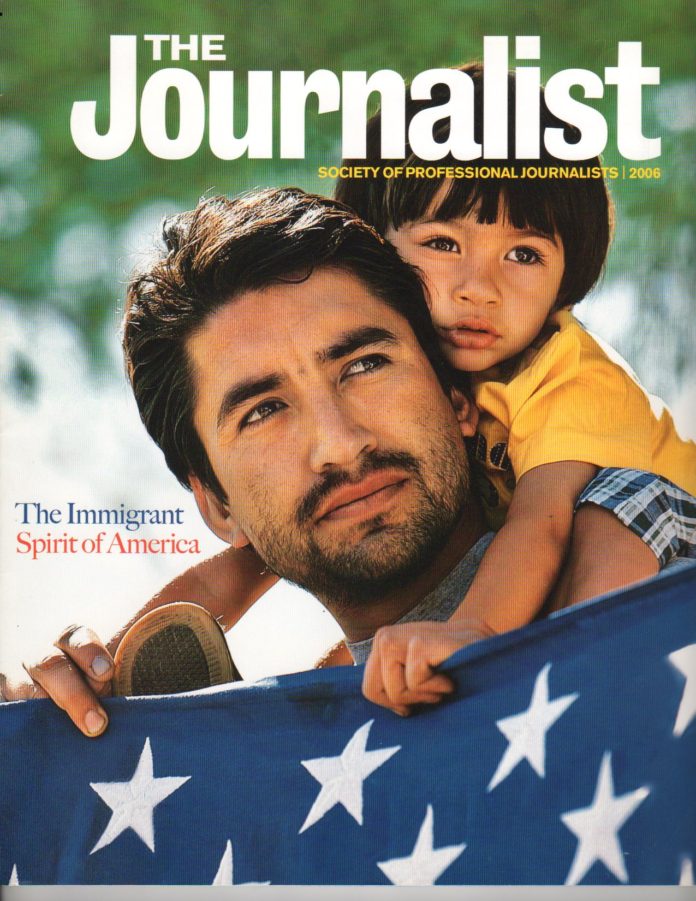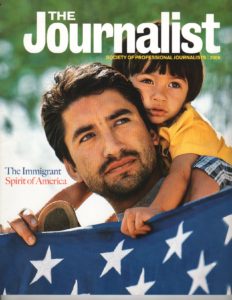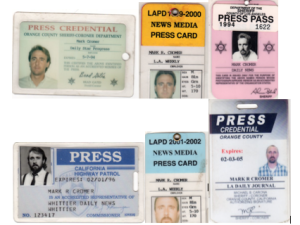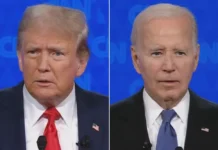
When it comes to illegal immigration, many journalists just stick to the script
(Long before the rise of Donald Trump brought the Establishment Media’s true ideological group-identity into such stark relief over the issue of illegal immigration, as a press card-carrying member of it I thought it worth exploring, in real terms, just how much of an honest discussion could be had over the issue among the members of the credentialed press. This column was first published by Santa Barbara think tank Californians for Population Stabilization in January of 2007 as part of an occasional series on the media’s coverage of illegal immigration and overpopulation issues. Immediately following its publication I was promptly disinvited to a birthday bash for a Los Angeles Press Club board member and my invite to the annual gala that year got lost in the mail. Bummer.)
By Mark Cromer
As an active member in ‘good standing’ of both the Los Angeles Press Club and the Society of Professional Journalists, I was quite confident last summer that my offer to organize a panel discussion of a hot-button issue would be readily embraced by both associations.
I proposed that we assemble a group of reporters and media wonks to dig into an issue at the core of the illegal immigration debate and its coverage in the news: the ubiquitous practice of labeling opponents of illegal immigration as “racists,” “xenophobes” and other toxic terms that smacks of a new McCarthyism.
Do reporters have an ethical obligation to weigh the validity of such accusations of racism?
Or do our professional standards release us from anything beyond slipping the charge between quotation marks and letting the reader sort it out? Is there any threshold of authenticating the claims of an accuser leveling these charges? Is there any burden upon the person making the charge to demonstrate that the person they are calling a bigot actually is one?
What news value is brought to the reader by merely passing along such polarizing rhetoric?
It’s a hot issue, it’s a great opportunity to explore an ethical question that’s central to how we do our jobs as journalists and I was volunteering to help put a panel together that would feature divergent perspectives on the matter. I figured it was a no-brainer.
That was in August.
Going on five months later, I am still waiting to hear back—even a courtesy ‘no thanks’—from Anthea Raymond, a reporter for NPR and the president of the Los Angeles Press Club, to whom I directed my pitch.
Just to make sure my proposal was not lost in the shuffle, I followed up repeatedly as the weeks and months rolled by; via certified letters, emails, faxes and phone messages taken by the press club’s executive director Diana Ljungaeus—who assured me that Raymond had indeed received my proposal and follow-up correspondence.
“I don’t know why she hasn’t replied,” Ljungaeus mused.
Well, I think I do.
As the head of the dominant press association in greater Los Angeles, I suspect that Raymond is really just doing her job by ignoring the proposal and its central question. An open, freewheeling and, God forbid, critical analysis of how the media is handling this issue is simply not in the cards. It’s nothing personal.
That stonewall deftly displays the arrogant contempt that is deemed mandatory in much of the media today at even the suggestion that the press is out of touch with the rest of America on the issue of illegal immigration.
Raymond’s silent treatment is the outward expression of that contempt: the very premise of the proposal is unworthy of even a response, let alone honest consideration. She may not have personally bristled at my request, but Raymond clearly feels comfortable that the Los Angeles Press Club is in ideological lock-step enough on this issue that she could safely discard it without so much as a reply.
And that says a lot.
You’d be hard pressed to find a more sacred, gilded cow among much of the traditional media today than that of the “undocumented worker.” Conventional wisdom at news desks and among editorial boards across the country clings desperately to the central tenet that the illegal immigrant living in America today is oppressed and impoverished, indentured and abused.
As the cliché goes: illegal immigrants are “living in the shadows.”
Accordingly, the heavy in this storyline are the citizens, particularly of the white variety, who dare to speak out against illegal immigrants and the corrosive impact they are having on local and state budgets, the environment and the quality of life in working and middle class neighborhoods.
By definition alone, white citizens in this media production tend to be mean-spirited and bigots by association, if not at heart. It’s a script that has been in circulation so long throughout newsrooms that I am surprised it hasn’t been codified in the AP Stylebook—yet.
In Los Angeles, this schematic is now as fundamental to reporting the issue of illegal immigration as learning the ‘inverted pyramid’ style is to students in Journalism 101.
Unlike Raymond over at the LAPC, the Los Angeles chapter of the Society of Professional Journalists did manage to respond, after a couple of months and several follow-ups on my part in an effort to shake an answer out of them. Chapter President David Dow, formerly of CBS News, informed me that my proposal had been scheduled for discussion, but was then put on hold since the SPJ “diversity chair” was not at the meeting.
Raised at a later meeting of the SPJ board, Dow emailed me to say that the board determined that my proposal was “a legitimate part of a broader discussion of journalistic coverage of race-related issues.” Dow thanked me for taking the time to pass my proposal along and noted it would be kept on file for possible use at a future date.
As the saying goes around Hollywood: “Don’t call us, we’ll call you.”
Whether Raymond’s icy silence or Dow’s polite brush off truly reflects an attitude prevalent among the national press associations was at least partly answered last year by a cover story in The Journalist; the glossy trade magazine published by SPJ.
Entitled “The Immigrant: Spirit of America,” the cover photograph features a father with his small daughter sitting on his shoulders, both grasping an American flag. It’s a great shot that evokes powerful symbolism.

But journalist Brian Grow’s story gives light to the message behind the cover photograph, which is yet another depiction of white citizens as one-dimensional racist caricatures. Grow compares illegal immigrants to the African Americans who struggled for their constitutional rights (conveniently skipping the part about blacks being American citizens), evoking Martin Luther King and violent Freedom Summers.
Then, on cue, the modern day descendants of Sheriff ‘Bull’ Connor makes their appearance.
“There is an ugly side,” writes Grow, a reporter for Business Week in Atlanta. “Those seeking a crackdown muster their forces to patrol the southern border, blame immigrants for disease, report them to police and harass them at job sites.”
In case you missed the point, Grow brings it home by noting “The anti-immigration cabal will rail that the nation is being overrun with freeloaders, leaving schools burdened, jobs poached.”
Grow’s closing summation suggests that if America succumbs to actually enforcing its immigration laws and protecting both its sovereignty and its citizens, it is the Klan that will have prevailed.
It’s not that the inspiring stories of immigrants—both legal and illegal—should not be told in the media. Nor is the problem that writers like Grow unabashedly embrace them to the point of intentionally stilting the portrayals of those opposed to illegal immigration in such a poisonous manner that it becomes propaganda—not honest journalism.
The problem rests, journalistically, when the same storyline is recycled again and again, at the expense of other competing and often contradictory stories. While the struggling undocumented worker has approached mythic lore in the media, Americans and particularly whites are left wondering whether their stories of economic hardship and displacement matter; whether their views on illegal immigration count?
Increasingly they have reached the conclusion that they don’t.
While right-wing pundits tend to view Grow’s perspective as a pathetic manifestation of “white guilt” that runs abundant in an overwhelmingly liberal profession, they overlook the more potent vein of class-status that courses deep through such stories.
Reporters radiate such disdain for the white working and middle class—and therefore so easily affix the dismissive label of “bigot” upon them—because they tend to view them as losers; as embarrassments; as a rabble of distant relatives better to be avoided.
Championing the huddled masses of impoverished, illiterate economic refugees fleeing the failing nation-state of Mexico and yearning to breath free makes these same journalists feel better about themselves; even as it reinforces their own quiet notions of superiority. Listening to whites describe their frustrations, struggles and hardships as a result of the impact of illegal immigration is simply counter-intuitive for many reporters. They just don’t go there.
Indeed, the dirty little secret among reporters in major metro markets like Los Angeles is that the white working class that still dominates the nation’s heartland is viewed as little more than a tribe of red state cavemen who hunt, drink beer out of cans, listen to country music, failed their GEDs and sadly cling to outdated religious values that are based upon superstitious concepts like ‘good’ and ‘evil.’
In the minds of many major metro scribes, the great geographical sweeps of white America is truly The Land That Time Forgot. They deride it as ‘fly over country,’ a place that’s better viewed from 35,000 feet while en route to the coasts.
So when Anglos living in the seemingly cosmopolitan oasis of Southern California take a position against illegal immigration, it immediately evokes a visceral reaction from news desks and editorial writers alike.
And thus when a story is written about white activists opposed to illegal immigration, the inclusion of a quote or two from a Chicano Studies professor or a Latino activist calling them racist hate-mongers becomes standard issue. Even if the action proposed by the anti-illegal immigration activists is seemingly benign, their personal motivation, as a result of their whiteness, is always suspect.
Deep-seated anger over the one-dimensional portrayals of whites in the media and their total exclusion from having an ethnically identifiable voice on the editorial pages is the jet fuel that has propelled talk radio in LA, making KFI 640 and KABC 790 twin outlets for largely working and middle class whites’ views.
Not surprisingly, the stations have been dubbed ‘Hate Radio’ by a media establishment furious that Anglos might demand some semblance of equal time given to their perspective on the issues.
This journalistic orthodoxy has ruled at a price for some traditional news outlets in the City of Angels. The Los Angeles Times has hemorrhaged readers and credibility for years; in no small part as a result of its editorial page view increasingly dictating how it covers illegal immigration and race relations on its news pages.
The newspaper that legendary publisher Otis Chandler had once pushed into greatness recently suffered a devastating left hook from the LA Weekly, which exposed the Times’ soft-peddling an explosive story of three white women who were victims of a brutal hate crime.
Of course, the Times didn’t have much to say about the Weekly’s detailed evisceration of its anemic and slanted coverage of a story that would have dominated the Times front page every day with multiple bylines and shrieking headlines—if only the victims had been the right color. Or more specifically, had more color.
Like Raymond’s official silence on behalf of the Los Angeles Press Club, the Times brooks few questions over the editorializing of its news coverage, but instead marches stoically back to a leftist variant of its pre-Otis roots, when the newspaper was little more than a cheap shill that served California’s then-powerful rightwing.
Perhaps I am being too hard on Raymond and too suspect of Dow at SPJ.
After all, I have long known that both professional associations, in Los Angeles anyway, are frequently nothing more than a tax-deductible reason for journalists to dress up and party down.
And perhaps the only thing reporters love more than a hosted bar is an award with their name on it, thus both clubs work feverishly to fulfill those needs.
When I renewed my SPJ membership late last year, I received a DVD in the mail of the group’s annual awards bash. A few weeks later, SPJ sent me a survey about the DVD, apparently in an effort to devise an even bigger and better awards show that members can watch over and over again.
Yet I can’t believe the SPJ fete could top the Los Angeles Press Club’s annual orgy of self-congratulatory indulgence: the Southern California Journalism Awards. A glitzy night held in elegant ballrooms, the LAPC’s awards blowout allows reporters to bask in a low-watt version of the Oscars, complete with emotional acceptance speeches bathed in the glow of spotlights.
Such fleeting recognition may indeed be well deserved by reporters who nail a great story, but as a profession we should demonstrate our accountability to a higher standard through tangible actions, not just rhetoric from the dais.
While the courtesy of a reply would have been, what’s the word—professional?—I suppose if Anthea Raymond can raise enough money to pay for the annual bash and its shiny trophies, well I guess that’s enough.

Oh, I did finally get a letter from the Los Angeles Press Club last week; albeit a photocopied form letter. Raymond and the board thanked me for renewing my membership.
Not to worry.
As Groucho Marx was fond of saying: “I’ll join anyone for a drink.”
But sometimes that’s about all this press club is worth.










